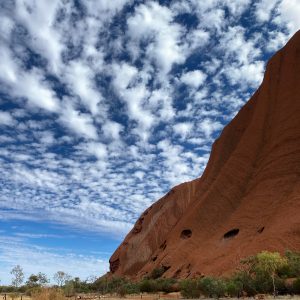We know you are probably familiar with what Uluru looks like, where it is and other general information that has become prominent in society. But do you know its strong cultural significance to Australian Aboriginal people?
On our tours of Uluru, you can learn more about this important topic; however, for those who have not yet had the opportunity to join SEIT on an outback adventure, we thought we might offer some historical information about Uluru and its relationship to the local Anangu people!
Aboriginal Culture and History
While research varies on the exact timeline, it is estimated that the Australian Aboriginal culture has existed for at least 60,000 years, making it the oldest continuous culture in the world. This means that while different cultures have historically been transformed by things like colonisation or intermingling with other cultures, Aboriginal culture remains largely unchanged. Traditional beliefs and laws of their ancestors are still relevant today, having been passed down through generations via stories and rock art that remains visible in many significant sites, such as Uluru.
Anangu people, the traditional owners of Uluru-Kata Tjuta National Park, have a rich history with their land, viewing Uluru as being entwined with Tjukurpa (traditional law). Tjukurpa for the Anangu is the basis of their culture and way of life, wherein the people and the land are one and cannot be separated.
According to Tjukurpa times, our world and everything in it was historically created by ancestral beings. Some of these locations formed by the ancestors are considered sacred to the Aboriginal people, including Uluru and its many caves.
If you would like to learn more about Australian Aboriginal culture and the history of the land and its people, our SEIT Patji tour is not to be missed.
Why can’t I climb Uluru?

It’s likely you remember when visitors were able to climb Uluru, given it was still happening not that long ago! Nevertheless, it is and has always been a sacred site to Anangu, and Tjukurpa typically did not allow the climbing of Uluru.
After Uluru-Kata Tjuta National Park was returned to its Traditional Owners in the mid-80s, cultural discussion began regarding whether the climbing of Uluru should be stopped. While the sharing of Anangu culture and wishes surrounding Uluru to visitors did lead to a reduction in climbing, it wasn’t until 2019 that the climb was officially closed.
This decision respects the culture of Anangu, the Traditional Owners, their law, and the land itself. You can hear more about the history and culture surrounding Uluru on our SEIT Uluru Trek tour, along with getting some beautiful photos! However, be mindful that there are some sites at Uluru that are culturally sensitive to Anangu and are therefore not allowed to be photographed.
If you are concerned about accidentally taking a photo of one of these sites, don’t worry! There are signs throughout the park telling you when you are in a sensitive area and are therefore not to take pictures of the rock formations. If, instead, you decide to capture photos of the incredible flora and fauna in these areas – and we invite you to do so! – just make sure none of your photos contains any evidence of the sacred rock formations.
How is Rock Art Significant to Aboriginal Culture?
Rock art has been historically used to share wisdom and education of Tjukurpa throughout multiple Anangu generations, making sites that feature rock art vital to Anangu and other Indigenous Australian cultures. Dozens of rock art sites are found throughout Uluru, further cementing its significance in Aboriginal culture.
Paint was created by Anangu using natural materials such as ash, which they combined with water and coloured with materials like red and yellow ochre. If you’ve seen traditional Aboriginal art, you’ll know that red and yellow are prominent colours, along with white and black.
Unfortunately, the usage of these natural materials means the art is susceptible to wear and tear and easily damaged. Given the importance of rock art in Aboriginal culture, it is essential all artwork be preserved as much as possible. For this reason, a number of viewing platforms are available at Uluru, allowing visitors to best see the art while also protecting it from being potentially touched or impaired.
If you are interested in seeing traditional Aboriginal art at Uluru and learning more about its significance to Anangu culture, the Mala walk and Kuniya walk provide great opportunities. Our SEIT Uluru tour offers access to both those walks, along with a guided tour to the entrance of Mutitjulu Waterhole, where you will learn Creation stories such as Liru (poisonous snake) and Kuniya (python), along with other notable Tjukurpa stories.
